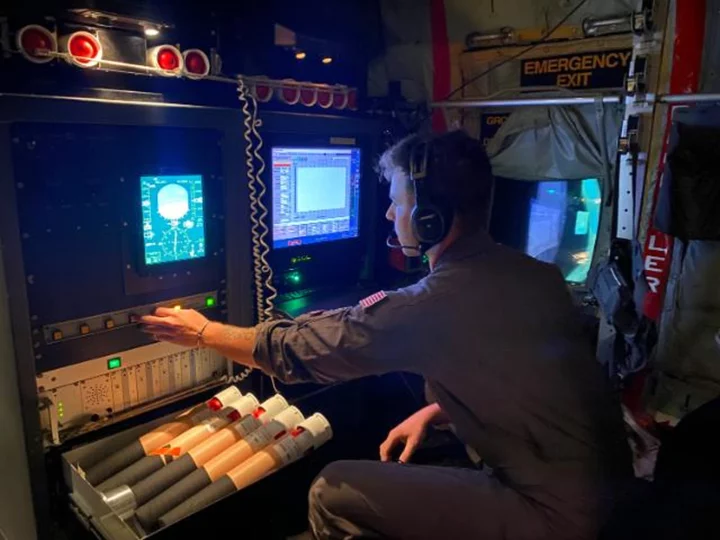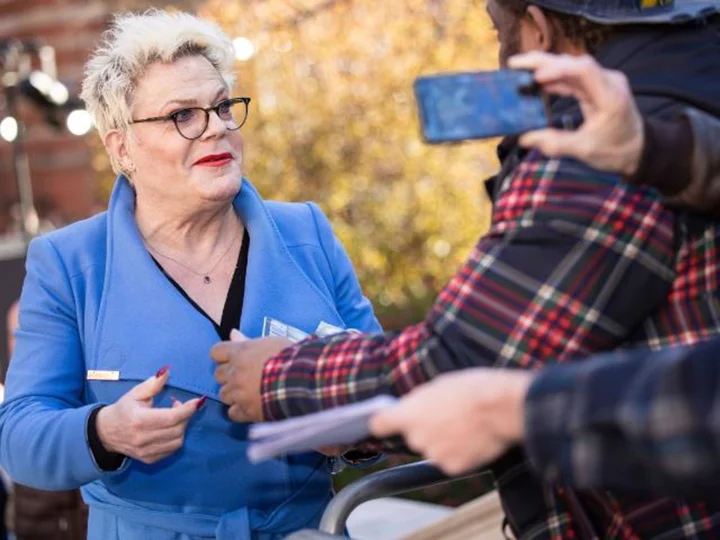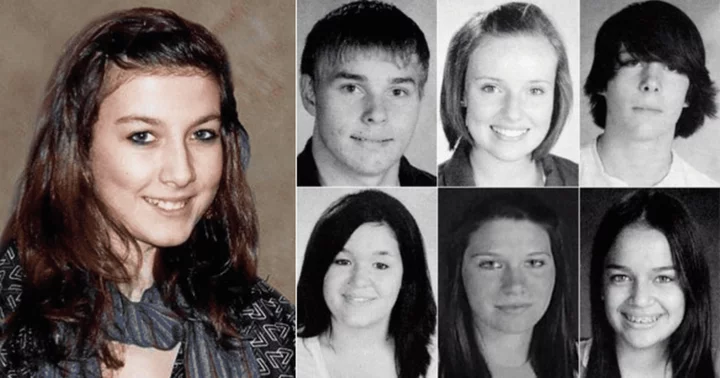The warning came early.
One pilot told me right at the beginning, before we took off, that it would be a really rough ride. He said the storm was intensifying so rapidly that it would have a ton of spin up tornadoes and rough turbulence.
He warned me. I flew Hurricane Dorian in 2019 with the US Air Force Reserve hurricane hunters when Dorian was a Category 5 over the Bahamas and that was a completely smooth ride. So the bigger the hurricane doesn't always necessarily mean the rougher the ride.
The WC-130J Hercules aircraft from the 53rd Weather Reconnaissance Squadron departed Keesler Air Force Base in Biloxi, Mississippi, Tuesday at 11 p.m. ET.
Idalia would make landfall as a Category 3 hurricane with sustained wind speeds of 125 mph about 7:45 a.m. Wednesday in Florida's Big Bend region -- where the panhandle meets the peninsula. Its storm surge was record-breaking from Tampa to the Big Bend.
A midair change of plans
It was a very short ride to the outer bands of the hurricane over the Gulf Coast. It took a little less than 30 minutes to actually reach the leading edge.
At the last minute, the National Hurricane Center changed our flight plan and had us go into a different part of the storm instead of the original entry point. It was determined the spot we were originally going to go into was too dangerous.
This was called the landfall flight -- technically the last flight before the storm made landfall. We were only supposed to be in the air about eight hours. We ended up being in the air a little over 10 hours. The hurricane center just decided they were going to keep us in the eye as long as we could before landfall and then, they had us do what's called shore patrols -- going up and down the shoreline at a very low altitude just getting readings of the wind sheer and the temperatures. We made about a dozen passes up and down the Florida shoreline.
Before we took off, First Lt. Zach McDermott, a 53rd Weather Reconnaissance Squadron pilot, told me to make sure I was in my jump seat as much as possible. I could tell he knew it was going to be a rough ride. The entire flight crew was so awesome. They gave me headsets so that I could listen in on conversations between the on board meteorologist, the navigator, and the flight director and the pilot the whole time.
Everybody had such a specific job. The coolest one on the plane is the in-flight meteorologist because his job is to just scrub that radar. From the moment we penetrate the storm, he's focused on the radar, looking for those tornado signatures and rough turbulence. He relays the location to the navigator, who tells the pilot how to steer clear of it so that literally we don't run smack dab into a tornado inside the hurricane.
This is what happens in the movies
The one time my soul left my body, I was on the flight deck with the pilots. It was dark the majority of our flight. The lightning was so intense, and the hail hitting the plane was so intense.
"We're about to go through the eye wall," a crew member said.
I'm sitting up there with the pilots. We're rocking and swaying, and all of a sudden, the flight controls start screaming, "Check Altitude. Check Altitude. Check Altitude. Throttle up. Throttle up." And I'm like, 'Oh my god, this is what happens in the movies.'
And those pilots were just cool, calm and collected, and steered us through it. It was amazing. We had one moment where we dropped really rapidly because we hit a pocket and everybody on the plane literally levitated. We were kind of airborne. Again, the hurricane hunters didn't think anything of it. It was little ol' me sitting there, my soul leaving my body.
I am a bit of an adrenaline junkie; I almost went into the Navy because I wanted to be a fighter pilot. So now my dream is, as a journalist, to fly with these guys and show the world how cool they are. And that's sort of how I ended up flying on Dorian. Everybody was so serious on this flight. I think they knew how rough it was going to be. I was like, 'Okay, I've got to not freak out and just kind of go with their tone.' That's just kind of what I did. We had a big drop in a matter of seconds. No biggie.
"That was pretty intense," one crew member said.
"Yes, it was the biggest bump I ever felt," said another.
"What do you think, Victoria?"
That was crazy. I was holding my breath the whole time.
'Yes, we just hit Cat 4'
Minutes after the severe turbulence signaling the rapid intensification of the storm, readings began to come in from weather buoys and the sensors that measure temperature, pressure, wind and the humidity of the atmosphere.
"Yes, we just hit Cat 4," the pilot announced.
We went from Category 2 to Category 4 in a short amount of time. We were in the eye of the storm for a good eight hours. Just zigzagging in and out, penetrating different parts of the eye wall and then going back into the eye. We knew we were in the eye and that's when everybody kind of got up. They would get a drink of water.
In the eye itself, it was super calm. There was no turbulence. As soon as we started to rock a little bit everybody ran back to their jump seats and sat down. As we're crisscrossing in and out, you can feel every time we reentered the eye wall. You could feel the intensity of the turbulence a little bit more, then a little bit more, and a little bit more. Every time.
It's a big plane. When it tilts to the side, it really tilts to the side. It's a big tilt back and forth, almost like you're on a big tanker out in the ocean with big waves. It's a big drop and then a big back up. And then it'll drop down to the front. The nose will go down a little bit. Then you have the violent shaking, too, from the really intense wind sheer. You have all of this combined.
Pilot was 'kind of new to this'
On the flight deck, there are little bunk beds for the pilots. They have four pilots on board at all time: Two pilots in the seats, and then the other two are mandatory laying down trying to nap. They switch out every two, three hours depending on how long the flight is.
During some of our really rough turbulence, those guys were still walking around, just hanging on to what they can hang on to because they've got a job to do. Everybody's job is so vital to the mission and so crucial to the safety of that flight that they can't stop when there's turbulence. They have to keep doing what they need to do. It was serious. It was all business. Hours later, the aircraft approached Keesler over the glistening water and landed safely. It felt good to be back on solid ground.
Once back at base, the crew appeared relaxed. I was with these guys for over 10 hours, from the pre-flight briefing through the flight, through landing and deboarding, and it was like literally the first time they breathed a sigh of relief. They were joking. It was like loosening your tie at the end of a hard day at work.
McDermott's a relative newbie to the hurricane hunters. He's a young pilot, but he's good at what he does. He did such an amazing job. I was shocked to find out he has only been flying with the hurricane hunters for a little over a year.
He was so cool and calm under pressure. And he knew exactly what to do. He communicated so precisely and so calmly over those headsets to everyone when we were in kind of dangerous territory.
He even asked me, "Will you send me some of the pictures that you took from the flight deck?" He was like, "I'm kind of new to this so I don't have a lot of pictures."









